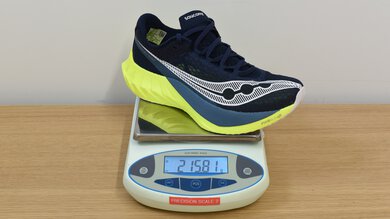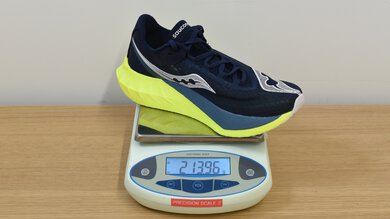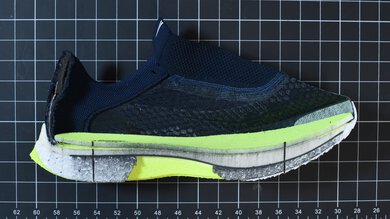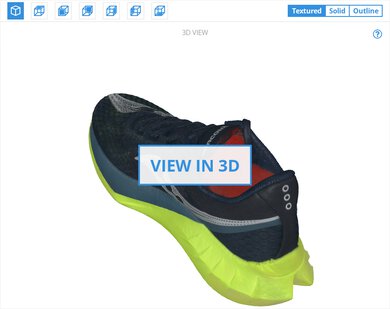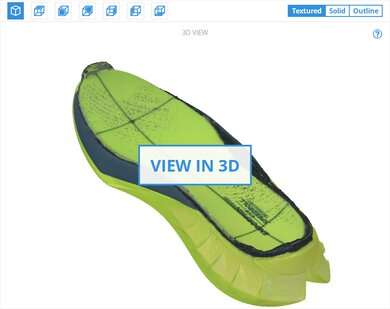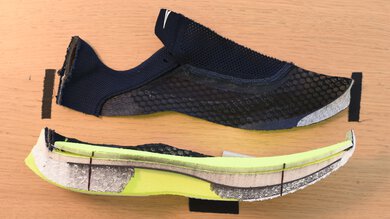The Saucony Endorphin Pro 4 is a high-performance running shoe engineered for race day that also works well for faster workouts. Equipped with a dual-layer midsole and a full-length carbon fiber plate, it promises a lively, smooth ride that feels efficient and quick on the road. The spacious and breathable upper adds comfort for longer runs, while the well-covered outsole feels durable.
Our Verdict
The Saucony Endorphin Pro 4 is very good for marathons, offering a balanced combination of low weight, great energy return, and decent cushioning. It also has good lateral stability, which is rare for a super shoe, making it a good option for longer distances when form starts to break down. However, the foam's firmness can make it feel a bit harsh on the feet after a while.
-
Good racing option for heel strikers.
-
Balanced bounciness.
-
Not the most protective for longer distances.
The Saucony Endorphin Pro 4 is great for shorter-distance racing. Its impressive forefoot firmness and good weight provide a responsive and efficient running experience. The great energy return is also a significant contributor, making it a preferred choice for these distances where speed is king.
-
Firm forefoot foam.
-
Good racing option for heel strikers.
The Saucony Endorphin Pro 4 offers very good energy return, with the forefoot and heel contributing equally to this bounciness. The dual-layer PEBA-based foam enhances the overall running experience by providing a responsive feel during foot strikes. It can handle both faster training sessions and races.
-
Balanced bounciness.
-
Dual-layer PEBA foam.
The cushioning is evenly distributed between the heel and forefoot of the Saucony Endorphin Pro 4, providing a decent level of protection underfoot. This ensures a comfortable ride without compromising too much on responsiveness and weight.
-
Not the most protective for longer distances.
The Saucony Endorphin Pro 4 provides good lateral stability, particularly due to its wide base and very firm forefoot foam. This is beneficial for maintaining balance and efficiency, especially during longer runs. However, the high stack height makes you feel quite high off the ground, which can affect stability. That said, it has great stability for a super shoe without affecting other aspects negatively too much.
-
Firm forefoot foam.
-
Wide and quite firm base.
-
High stack.
- 7.9 Marathon Racing
- 8.5 5K/10K Racing
Performance Usages
- 8.2 Energy Return
- 7.1 Cushioning
- 7.5 Lateral Stability
Changelog
-
Updated Apr 23, 2025:
We updated the comparison in the Weight box with the latest Vaporfly iteration, the Nike Vaporfly 4.
-
Updated Apr 09, 2025:
We added a comparison with the adidas Adizero Adios Pro 4 in the Compared To Other Running Shoes section.
- Updated Apr 02, 2025: Converted to Test Bench 0.8.
- Updated Apr 02, 2025: Review published.
Differences Between Sizes And Variants
We tested the Saucony Endorphin Pro 4 in men's US size 9, as indicated on the label. The color shown here is Navy/Citron. This model is also available in other colorways, including White/Silver, Black/Electric Aqua, and White/Black.
Wide versions aren't available for this model.
Compared To Other Running Shoes
The Saucony Endorphin Pro 4 is a well-balanced super shoe that blends speed, cushioning, and stability more seamlessly than many of its competitors. While it's great as a racing shoe, it leans toward the firmer side and isn't the most cushioned option, making it particularly well-suited for shorter distances like 5Ks and 10Ks. That said, it's still a capable marathon option, though not as specialized for long distances as some other super shoes like the Nike Alphafly 3 and the adidas Adizero Adios Pro 4.
This feature combination positions it among shoes in the unofficial 'hyper trainer' category—primarily built for racing but versatile enough to handle track intervals and even uptempo workouts without feeling overly aggressive.
Within Saucony's lineup, the Endorphin Pro 4 sits above the Saucony Triumph 22, a max-cushioned daily trainer, and the Saucony Endorphin Speed 4, a versatile super trainer with a PEBA midsole and nylon plate designed for a mix of training and faster efforts. However, it sits below the Saucony Endorphin Elite 2, Saucony's top-tier, most aggressive racing shoe, which is built purely for absolute performance.
For more options, check out our recommendations for the best running shoes to find the perfect pair.
The Nike Vaporfly 3 and the Saucony Endorphin Pro 4 are both popular super shoes with the same overall level of cushioning, but their ride characteristics differ. The Endorphin Pro 4 offers more balanced cushioning throughout, while the Vaporfly 3 has better heel cushioning but lacks forefoot protection. The Vaporfly 3 also provides a bit more energy return, contributing to its propulsive feel, but the Endorphin Pro 4 is significantly more stable, thanks to its wider outsole. Additionally, the Vaporfly 3 is lighter, giving it a more effortless, race-day-ready feel, while the firmer forefoot foam adds to its snappy toe-off compared to the smoother, more controlled ride of the Endorphin Pro 4.
The Nike Alphafly 3 and the Saucony Endorphin Pro 4 are both high-performance racing shoes, but they cater to different types of runners and preferences. The Saucony is stiffer in the forefoot, providing a more structured toe-off. It also offers greater lateral stability than the Nike, benefiting runners who need extra support during turns. Additionally, its geometry is particularly well-suited for heel strikers. On the other hand, the Nike shoe excels in energy return and overall cushioning, maximizing efficiency over long distances. While the Saucony is an excellent option for both racing and versatile enough for workouts, the Nike remains hard to beat for those prioritizing raw speed and performance.
The Saucony Endorphin Pro 4 and the adidas Adizero Adios Pro 3 are both high-performance racing shoes, but they cater to slightly different strengths. The adidas offers more cushioning and better energy return, making it feel softer and more efficient. In contrast, the Saucony is notably more stable and features a stiffer forefoot, which helps create a dynamic, snappy ride, especially beneficial for shorter races like 5Ks and 10Ks. Additionally, the Saucony is slightly lighter, giving it a more agile feel. Overall, the Saucony is probably the better race-day option for most.
The Nike Vaporfly 4 and the Saucony Endorphin Pro 4 are both carbon-plated super shoes built for race day, but they offer different strengths. The Vaporfly 4 is significantly lighter and geared toward runners prioritizing absolute performance and efficiency, especially over half-marathon distances. The Endorphin Pro 4, while heavier, provides more stability, and it has a firmer forefoot that delivers a snappier toe-off.
The Saucony Endorphin Elite 2 and the Saucony Endorphin Pro 4 are both carbon-plated super shoes, but they serve slightly different purposes. The Elite 2 is lighter, softer, and more deeply cushioned, offering a highly energetic ride that excels in the marathon, where protection and efficiency are key. However, its ultra-soft midsole can feel overly mushy for shorter events, lacking the snappiness some runners appreciate. The Endorphin Pro 4, while slightly heavier and firmer, is more stable and versatile—it performs well across a wider range of distances, including shorter races and even track workouts. For runners chasing maximum performance and comfort over long distances, the Elite 2 is the superior tool. But for most, the Pro 4 offers a more practical and well-rounded race-day experience.
The Saucony Endorphin Pro 4 and the PUMA Deviate NITRO 3 both offer a similar level of cushioning, but they serve slightly different purposes. The Puma is a super trainer with a carbon plate, making it great for high-performance training, while the Saucony is a versatile super shoe primarily built for race day. Despite their similarities in cushioning, the Saucony is the better option for most runners since it is lighter, more stable, and more energetic, providing a snappier, race-ready feel. The Puma, while still capable of fast efforts, leans more toward durability and daily versatility rather than outright speed.
The Saucony Endorphin Pro 4 and Mizuno Wave Rebellion Pro 3 are both carbon-plated super shoes, but each caters to different racing scenarios. The Saucony is better suited for shorter distances thanks to its lighter weight and firmer forefoot. It's also surprisingly stable for a super shoe, and its midsole feels more energetic. The Mizuno, while slightly heavier and softer, delivers a more cushioned and protective ride, making it better suited for longer races like marathons, especially for midfoot strikers able to activate the midsole fully.
The On Cloudboom Strike and Saucony Endorphin Pro 4 are both high-performance racing shoes but excel in different ways. The Saucony is more stable, provides better energy return, and has a stiffer forefoot foam, making it a stronger option for shorter-distance racing where a snappy, responsive ride is key. On the other hand, the On Running is more cushioned and lighter, making it a good choice for runners prioritizing comfort over longer distances while still maintaining race-day efficiency.
Test Results
This shoe is lightweight, making it quite efficient and suitable for various racing distances. However, some other super shoes, such as the Nike Vaporfly 4, are way lighter.
This shoe delivers excellent energy return in the heel, providing a responsive feel that enhances the overall running experience. Its design makes it one of the few super shoes that naturally accommodates heel striking.
The forefoot energy return is also great. The foam decompresses rapidly after each foot strike, providing a springy and efficient running experience.
The heel cushioning provides a decent level of protection underfoot, but it's not the most cushioned option available. As the miles add up, you may start to feel the impact from the ground more.
The forefoot cushioning is adequate, ensuring a balanced level of comfort for the runner. However, some other super shoes, such as the On Cloudboom Strike, offer significantly more cushioning in the forefoot.
The heel feels firm enough to provide adequate stability and support during runs. However, when higher forces are applied, such as when picking up the pace, the heel starts to feel softer compared to other shoes like the Nike Vaporfly 3.
The forefoot stands out with its impressive firmness, enhancing the shoe's overall stability while also aiding in a dynamic toe-off for a more propulsive stride.
Comments
Saucony Endorphin Pro 4: Main Discussion
Let us know why you want us to review the product here, or encourage others to vote for this product.
Update: We’ve converted this review to Test Bench 1.1. This update adds several new tests addressing Hardware Customization, Macro Keys And Programming, and Wireless Mobile Compatibility. We’ve also added new objective evaluations to the Typing Noise test, and we’ve simplified several tests and removed several others that were no longer relevant. For an in-depth look at all our changes, you can see our full changelog here.
- 21010
the bluetooth connection on this thing is not great. I bought it partly because of this article (years ago) but had to get something else eventually. I personally prefer a dongle as I switch between computers constantly (work/home) and using a KVM switch with dongle is much more reliable from hibernation.
That said, the RBG is great, and the proprietary software is pretty good. Though folks on forums have had issues with that as well.
Update: We’ve added a link to our ‘Best 60% Keyboards’ recommendation article in the Compared To Other Keyboards section.


